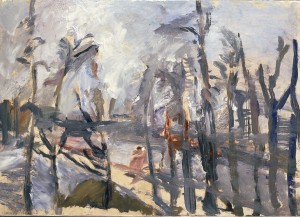In the hard, confident rhythms of the repeatedly varying compositions’ somber, broken, dark color chords there is no trace of drawing, no stylization, no painting as a style; there is painting as the life of a person, there is the living, impetuous, honest and open actions of an artist. There is nothing fictitious, there is no wanton appearance of the means of painting and gloating with them, no matter how beautiful they might be; there is the discipline of the work of a master, a movement from plausibility to truth, and truth simultaneously manifests as the beauty of the world and the beauty of art.
At the same time, it is not simply a landscape. We can only partially allow ourselves to read these works as a depiction of a place, of a geographical point on the surface of the earth. There much more here: there is immersion in the endless chain of events, and the significance of each of these events is profound. The pictures take the form not of testaments to the past, not of recollections, but of warnings that nothing is finished and that all of this is taking place right now. Events are very short-lived, but this does not make them any less significant. Quite the opposite, their meaning deepens and grows. This is the birth of the world, the eruptions in which the world becomes discernable and recognizable; this is the moment of creation, stretched to the limits of human understanding: now a person is a witness to the creation of the world: moreover, without his participation nothing takes place here.
The artist does not intend to order the world or bring it into harmony by translating it into the language of art. Here is something completely different: the voices of multitudinous powers, dark, internal and uncontrolled, ring out and ascend like a veil; here the chthonic world is almost discernable behind the drawn veil that separates it from modern culture. Sometimes it is as if it breaks through into this culture, illuminating an essence of harmony and beauty, fertilizing it with the seed of ancient knowledge. This is the restoration of a place that was nearly erased to the map, of a disappearing world, of a very old, almost forgotten language and a departing culture that speaks in this language. This is where Koroteev’s pictures come from, where he addresses us from. He paints from such a depth and mystery, and his painting is so modest that his language tends to be difficult to understand: his grammar is not so simple for a new time; and having understood, it is nevertheless difficult to believe in this world that emerges from the gloom.



